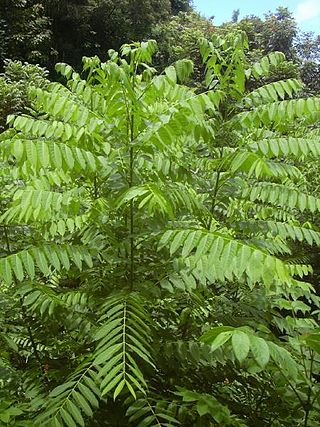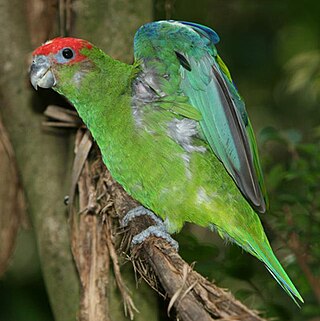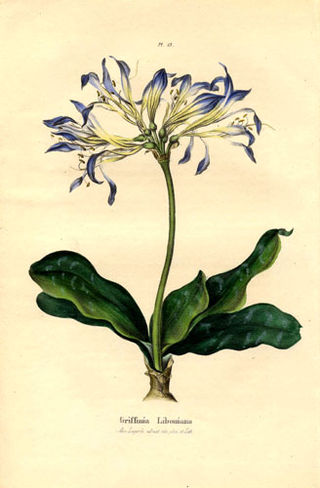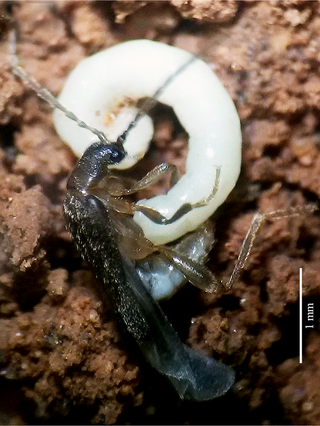
Genus is a taxonomic rank used in the biological classification of living and fossil organisms as well as viruses. In the hierarchy of biological classification, genus comes above species and below family. In binomial nomenclature, the genus name forms the first part of the binomial species name for each species within the genus.

The black-necked swan is a species of waterfowl in the tribe Cygnini of the subfamily Anserinae. It is found in Argentina, Brazil, Chile, Uruguay, and the Falkland Islands.

The coscoroba swan is a species of waterfowl in the subfamily Anserinae of the family Anatidae. It is found in Argentina, Bolivia, Brazil, Chile, Paraguay, Uruguay, and the Falkland Islands.

Alstroemeria, commonly called the Peruvian lily or lily of the Incas, is a genus of flowering plants in the family Alstroemeriaceae. They are all native to South America, although some have become naturalized in the United States, Mexico, Australia, New Zealand, Madeira and the Canary Islands. Almost all of the species are restricted to one of two distinct centers of diversity; one in central Chile, the other in eastern Brazil. Species of Alstroemeria from Chile are winter-growing plants, while those of Brazil are summer growing. All are long-lived perennials except A. graminea, a diminutive annual from the Atacama Desert of Chile.

Caiman is a genus of caimans within the alligatorid subfamily Caimaninae. They inhabit Central and South America. They are relatively small sized crocodilians, with all species reaching lengths of only a couple of meters and weighing 6 to 40 kg on average.

Oncidium, abbreviated as Onc. in the horticultural trade, is a genus that, as of December 2023, contains about 340 species of orchids from the subtribe Oncidiinae of the orchid family Orchidaceae. It is distributed across tropical and subtropical America from Mexico, Central America and the West Indies to northern Argentina, with one species (O. ensatum) extending into Florida. Common names for plants in this genus include dancing-lady orchid and golden shower orchid.

Arapaima gigas, also known as pirarucu or simply arapaima, is a species of arapaima native to the basin of the Amazon River. Once believed to be the sole species in the genus, it is among the largest freshwater fish. The species is an obligate air breather, so it needs to come to the surface regularly to breathe air.

Cedrela is a genus of several species in the mahogany family, Meliaceae. They are evergreen or dry-season deciduous trees with pinnate leaves, native to the tropical and subtropical New World, from southern Mexico south to northern Argentina.

The buffy-tufted marmoset, also known as the buffy tufted-ear marmoset or white-eared marmoset, is a New World monkey that lives in the forests on the Atlantic coast of southeast Brazil. Of all the marmosets, it has the southernmost range.

Pygmy owls are members of the genus Glaucidium. They belong to the typical owl family, Strigidae. The genus consists of 29 species distributed worldwide. These are mostly small owls, and some of the species are called "owlets". The genus includes nocturnal, diurnal, and crepuscular species. Birds in this genus mainly hunt large insects and other small prey.

Schinopsis is a genus of South American trees in the family Anacardiaceae, also known by the common names quebracho, quebracho colorado and red quebracho. In Brazil it is known as baraúna or braúna.

Rosewood is any of a number of richly hued hardwoods, often brownish with darker veining, but found in other colours. It is hard, tough, strong, and dense. True rosewoods come from trees of the genus Dalbergia, but other woods are often called rosewood. Rosewood takes a high polish and is used for luxury furniture-making, flooring, musical instruments, and turnery.

The short-tailed parrot is a species of bird in subfamily Arinae of the family Psittacidae, the African and New World parrots. It is found in Brazil, Colombia, Ecuador, French Guiana, and Peru.

The vulturine parrot is a species of bird in subfamily Arinae of the family Psittacidae, the African and New World parrots. It is endemic to Brazil.

The white-rumped hawk is a species of bird of prey in subfamily Accipitrinae, the "true" hawks, of family Accipitridae. It is found in Argentina, Bolivia, Brazil, Colombia, Ecuador, Paraguay, Peru, and Venezuela.

The caica parrot is a species of bird in subfamily Arinae of the family Psittacidae, the African and New World parrots. It is found in Brazil, French Guiana, Guyana, Suriname, and Venezuela.

The South American pileated parrot is a species of bird in subfamily Arinae of the family Psittacidae, the African and New World parrots. It is found in Argentina, Brazil, and Paraguay. It was formerly known as the red-capped parrot, easily leading to confusion with the Australian Purpureicephalus spurius that bears that English name.

Griffinia is a genus of Brazilian plants in the Amaryllis family, subfamily Amaryllidoideae. It includes 23 known species which are endemic to Brazil. The most closely related genus to it is the monotypic Worsleya.

Hylomyrma is a genus of ants within the subfamily Myrmicinae. To date it contains 30 known species.

Jurasaidae is a family of elateroid beetles known from around a half-dozen species in two genera found the Brazilian Atlantic rainforest including drier transitional areas bordering the Caatinga. All known species have neotenic larva-like females and normal males, similar to some other elateroids. They occur in the soil horizon immediately under leaf litter, with the larvae likely being fungivorous, consuming the fluids of fungal hyphae.




















